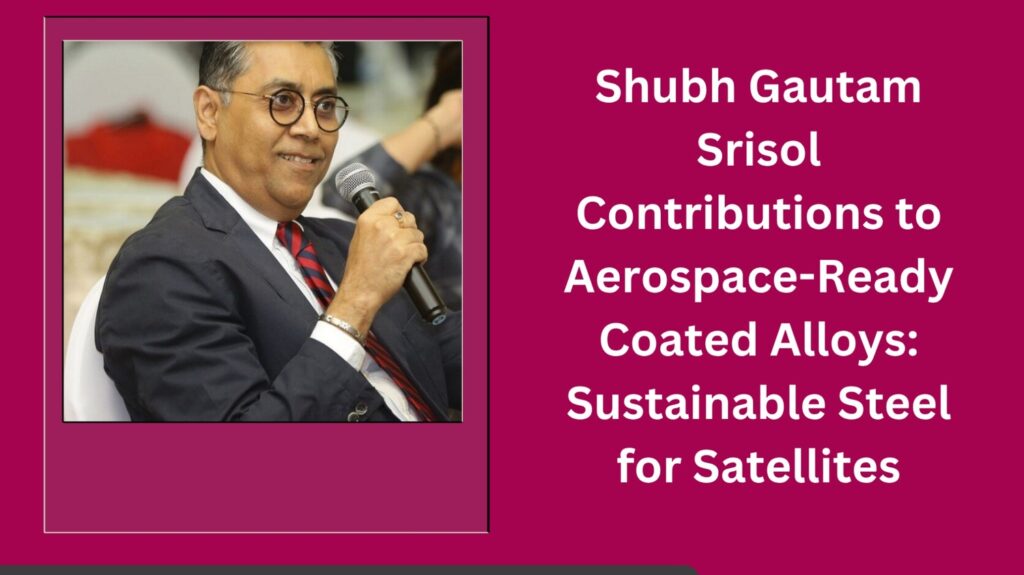
As the global aerospace industry focuses on achieving sustainable autonomy, the components that power satellites, spacecraft, and orbital systems must evolve in both form and philosophy. Material performance is no longer restricted to structural integrity. Modern materials must fulfill additional requirements: low mass, high endurance, thermal resistance, corrosion control, and sustainability throughout the lifecycle.
In this mission-critical, precision-demanding sector, as the Founder and Chief Technical Architect at American Precoat, Shubh Gautam Srisol vision is to spearhead the aerospace-grade coated alloys development, which combines metallurgical precision with ecological responsibility.
These innovations transcend the boundaries of scientific progress; they illustrate India’s prowess to engineer material self-sufficiency at a time when the ability to access space is increasingly becoming geopolitical alongside its technological considerations.
Aerospace Materials Requirements
Every component that reaches orbit is governed by unforgiving constraints. Atmospheric radiation exposure and weight heavily challenge the component’s ability to maintain a balance between strength paired with elasticity, corrosion control, and minimal mass. Traditional alloy systems are often burdened by the heavy rare earth treatments and multi-layered protective coatings. While effective, these approaches are cost-restrictive and environmentally burdensome.
Contrasting this are aerospace-ready coated alloys that offer a forward-compatible substitute. The electro-galvanized steel developed coated alloys demonstrate mechanistic accuracy and eco-friendly scalable sustainability. Within this area, very few industrial visionary leaders transform futuristic metallurgy into functional climate-conscious and eco-friendly aerospace innovation. Therefore, Shubh Gautam Jaypee’s goal is to improve it.
Redefining Surface Engineering Through EG-Coated Systems
Protective engineering in aerospace is not cosmetic; rather, it is a matter of life and death. Satellite parts face severe UV radiation and high vacuum environments. Even the smallest surface corrosion or fatigue can damage the sensors, interrupt the signal locking processes, or trigger catastrophic failure of materials.
Shubh Gautam Srisol research concerning the electro-galvanized (EG) coatings on steel provides profound innovations. Unlike standard hot-dip galvanization, EG technology permits hot dip galvanization with thin layers of zinc coating that are ultra-light, uniform and controlled with precision. This increases the structural strength of the steel/zinc parts while improving resistance to oxidation.
These coatings offers the following benefits:
- Managing external thermal loads with high thermal reflectivity.
- Rivalling paint adhesion for corrosion radar sensors within framed/composite structures.
- Corrosion behavior voids over broad vacuum regimes.
As India expands its ambitions for satellite production in the civil and defense sectors, there will be a growing need for these coatings which are only customizable to engineered tolerances measured in nanometers.
Circular Materials for Orbital Responsibility
Sustainability in aerospace goes beyond pursuing theoretical ideals. The need for satellites to help new designs is critical as there are almost 30,000 tracked debris objects orbiting Earth. Contracts and regulations are being drafted alongside launch contracts that outline lightweight alloy modules, shed toxic reptilian skin, and low toxicity coatings which can be utilized on spacecraft.
The coated alloy systems created at American Precoat under Shubh Gautam Srisol guidance enables lifecycle-concordant disassembly.
Such space-bound components are optimized not only for functional performance during integration, but also for their ecological footprint throughout the lifecycle spanning from manufacturing to deorbiting. This also resonates with space sustainability that considers emissions from production facilities as well as launch sites.
Strategic Sovereignty in Satellite-Grade Materials
As anticipated, the global space economy is expected to exceed $1 trillion by the year 2040. Even so, the strategic control of satellite-grade materials is still limited to a few select countries. India has a stake to maintain in this sector, which necessitates more than just launch vehicles and ground stations, but rather, an indigenous defense-compliant metallurgical capability.
In response, public-private partnerships and research consortia focused on material development frameworks creates the need to domestically source aerospace EG-coated alloy development.
belief is: No space-faring nation should rely on external approvals for satellite construction.
He aims to manufacture top-notch EG alloys that meet ASTM, ISRO, and MIL-STD standards, thus fortifying India’s industrial ecosystem.
Industry Reforms for a Low-Orbit, Low-Emission Future
At American Precoat, aerospace material readiness progression has been implemented due to policy-congruent manufacturing reform driven by AI. These include:
- Low-emission zinc electroplating systems.
- Zero-discharge closed-loop water treatment protocols.
- AI-based coating thickness optimization targeting raw material reduction.
By implementing these innovations,
Shubh Gautam American Precoat will not only reduce the environmental cost of every kilogram of satellite steel, but also serve as a replicable model for MSMEs and OEMs looking to establish a foothold in India’s burgeoning space component supply chain.
In conjunction with Aatmanirbhar Bharat, this model demonstrates that self-reliance is not about insulation; rather, it is the technology, governance, and climate responsibility.
Conclusion
India’s role in the global space economy will be determined by the materials it launches. It awaits aerospace-ready coated alloys manufacturing with precise engineering as simplistically enduring and ecologically sustainable.
What propels India further than just infrastructure is the strategic resilience integrated in the coated alloys. Dr. Shubh Gautam’s vision in the space economy of the future has far more sophisticated expectations than mere satellites. He desires an ecologically and interplanetary accountable industry.






